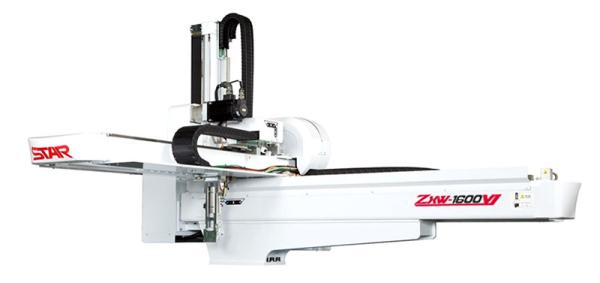
Star Automation’s IML Takes Crates from Anonymity into the Limelight
Every day thousands of plastic crates used for the packaging, transport and stocking of fruit and vegetables are being moulded all over the world. Most of these crates go unnoticed by us in street markets, supermarkets or greengrocers. With an in-mould labelling (IML) system, Star Automation can make crates stand out from the crowd.
In fact, not only does IML improve the look of the container itself, but also the perception of the quality and freshness of its content, which the buyer feels when looking at it. That’s how an impersonal and hardly recognisable object becomes an object of design, with character and appeal, which noticeably stands out among similar items.
Additionally, let’s not forget that as IML labels are made of plastic material and are thermally moulded in the product itself, this type of decoration makes the product totally recyclable and even improves its recyclability.
For more than 25 years, Star Automation Europe, distributed in the UK by Plastech Solutions, has been manufacturing IML automation systems for the most diverse sectors. Thanks to their expertise, they are able to provide flexible and highly efficient solutions. In particular, they have developed great experience in IML automation systems dedicated to fruit and vegetable crates, in particular for injection moulding machines with a clamping force ranging from 650 to 1000 tonnes.
Star Automation can offer a solution for all models of crates, from the classic ones (measuring 300x400mm, 300x500mm, 200x400cm etc. and with heights of 85mm, 105mm, 125mm as well as other sizes) to custom-made ones.
Usually, a standard IML automation system uses a six-axis robot; in Star Automation’s systems, though, beside the automation, they place a Star cartesian robot, which has some specific features and advantages.
The Star cartesian robot
Because of the considerable numbers, the most suited robot for this sort of application is Star Automation’s model XW-1800MVI, with its vertical stroke of 1800 or 2500mm. The traverse stroke can be adjusted according to the customer’s needs and goes from 3000mm onwards.
With a dry cycle time lasting less than two seconds, a cartesian robot ensures a faster actioning time in comparison with a six-axis robot, and this is something that must be kept in mind when a swift and continuous production is required.
Moreover, choosing a cartesian robot over a six-axis robot saves a good deal of space in your factory. As a cartesian robot is installed on top of the injection moulding machine and its controller sits on its main body, there is no need to place it on the ground!
The XW-1800MVI, which belongs to Star Automation’s top range series XV-VI, features a STEC-520A controller, which manages the entire automation.
It also complies with the standards set out by Industry 4.0 for the interconnection with the computer system resources of your company. When you choose a Star cartesian robot, you can be sure that you’ve selected state-of-the-art automation and, at the same time, you can benefit from the economic advantages you can get when innovating your company.
The End-of-Arm-Tooling (EOAT)
Star’s EOATs, which are used to load the labels in the mould, are made of carbon fibre; that’s why their EOATs are up to 20% lighter than standard EAOTs and improve the general performance of the robot and of the entire automation. Those who design and use EOATs know perfectly that with a lighter payload the robot works much faster, for a longer time and with lower maintenance costs. The lighter the EOAT, the more precise the positioning of the labels. Consequently, a faster cycle time entails higher productivity and a considerable reduction of production costs.
Star Automation’s EOATs for labels are quite different and truly innovative. Labels are not electrostatically charged by metal tips, but by a special bicomponent resin, which evenly shares electrostatic charge on the entire surface and reduces the weight of each EOAT for labels by 15%. Finally, the risk of electrostatic charges between the EOAT and the cavities of the mould is nil.
So, is it necessary to have an EOAT for labels for each model of crate? Not at all, if you choose Star! By adding special spacers, Star’s EOATs for labels designed for crates 300x400mm can be adjusted and also used on crates measuring 300x500mm.
The label magazine
Considering that usually the market requires the application of four labels on the crate (one on each side), Star Automation has designed just one model of label magazine, which has been standardised and is now suitable for several needs.
Their label magazine has a moving structure with two label containers; with this system, it is no longer necessary to stop the IML moulding cycle when one of the label containers gets empty. While the operator is safely loading one container, the other container provides the labels to the robot.
Why should you choose an IML system with a Star robot for your crates?
- To improve the impression of the crate quality;
- To enhance the perception of the content of the crate;
- To get faster moulding times;
- To gain greater space around the injection moulding machine;
- To guarantee a steadier production and a considerable reduction of refuse;
- To increase flexibility of your automated systems, thanks to the adjustability to different sizes;
- To have an automation system easy to set up and adjust.
Plastech Solutions are representatives for Star Automation in the UK. To download the brochure and request more information, visit Plastech Automation’s website.
Plastech Solutions
+44 (0)800 002 5687
Website
Email






